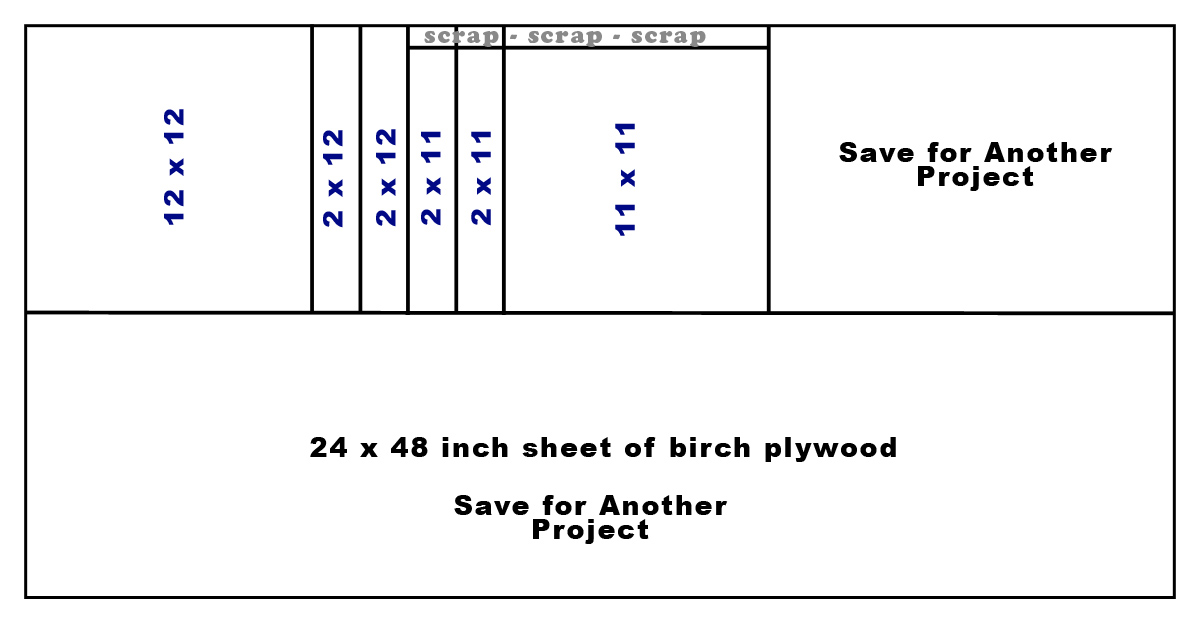With Halloween coming soon, everyone will want to make this awesome Demon LED Light Box! A great piece of artwork to display on the wall, desktop, or bookshelf! Awesome Haunted House Decor!
My big challenge for this tutorial was relearning a skill/craft as the project progressed using a table scroll saw. Something I had not used in 35 years.
This tutorial is dedicated to the Westlake High School Demons and Alum!
Step 1: Cut the WoodMaterials: Qty. (1) 2' x 4' x 1/2 inch sheet of birch plywood.
Tools: Table saw
Craft Store vs. DIY Store
For this project I started with a 1/2 inch x 2' x 4' sheet of Birch Plywood.
Let's start with the cost of wood for this project. At one of my local craft stores they had a 1/4 inch x 1'x 4' sheet of Birch Plywood for about $12. Seemed a little pricey and while the 1/4 inch board would probably be a little easier to work with on the table scroll saw, integrity of final project would probably be a challenge without additional corner supports. And, it would probably be challenging to air nail the pieces together working with 1/4 inch stock.
At the my local DIY store I was able to purchase a 1/2 inch x 2' x 4' sheet of Birch Plywood for only $10. Twice as much material for less, but a little more challenging to work with on the scroll saw.
Bottom line, head to the DIY stores to get more for less compared to the craft stores. This is assuming you have the tools to take advantage of the cost savings. In my case, a table saw. Craft stores upcharge big time for the convenience of nearly ready to go materials. In the long run, you are better off investing in good tools.
Diagram shows dimensions needed.
- Set table saw rip fence to 12 inches.
- Make your 12 inch cut.
- Set aside extra 1' x 1' section for another project.
- Cross cut a piece at 12 inches.
- Cross cut 4 pieces at 2 inches
- Cross cut 1 piece at 11 inches.
- Cut 1 inch off of two of the 2 x 12 pieces and the 11 x 12 piece.
- Save the scrap pieces.
NOTE: Not pictured is the 11 x 11 piece.
Step 2: Preparation for TransferThe design for this Demon Light Box is the official logo design for Westlake High School in Westlake, OH. If you are interested in the design, GO HERE to download.
Materials and Tools
- 12 x 12 piece of plywood
- Design to be transferred
- Painters tape
- Graphite Paper (transfer paper) also known as carbon paper.
- Measuring tape
- Blunt Pencil
To Do:
- With measuring tape, measure desired placement of design. (mine is centered)
- With painters tape, fasten graphite paper to plywood graphite side down toward wood.
- With painters tape, fasten design to plywood and graphite paper design upward.
After you are certain the graphite image and design pages are fastened securely, start tracing your image with the blunt pencil. Apply just enough pressure to transfer the graphite from the graphite paper to the wood. Not much pressure is needed. Just apply a little more than you would when normally drawing or writing.
Before removing your design, double check to be sure you have made all traces. It will be difficult to realign your design after removing the pages.
Step 4: Reveal Tranferred Design- Again, after you are certain you have traced your entire design...
- Peel back tape from plywood. If while you are peeling back from one edge assess the transfer. If you see any lines missing, then refasten the design and graphite paper and complete the traces.
- Remove design and graphite paper completely.
- Place side by side and compare.
- Sketch in any missing lines.
- Adore your ability to transfer an image!
Next take some time to shade areas that will be completely cut out. Depending on the design, you will need to take into consideration wood that will need to be left in to keep your project together. Cut too much wood and it all falls apart.
I have marked some initial DOTS where I think I will need to leave wood instead of continuous cuts. These DOTS will not be cut keeping the project together.
Step 6: Blade HolesTools
- Power Drill or Drill Press
- Drill bit.
Depending on the size of your saw blade, drill blade holes where you will insert blade through the scroll table and wood. I used 1/4 inch drill bit. to drill a series of holes to get me started.
Step 7: Install Scroll BladeTools
- Table Scroll Saw
- Scroll Saw Blades
- I used 18.5 tpi blades (teeth per inch)
You will need to install the scroll blade through your saw table and project piece through one of the blade holes. Start cutting!
As mentioned, it has been 35 years since I have used a table scroll saw. Check out some YouTube videos on inside cuts.
Step 8: Start CuttingIf you are like me, take some time to learn about your saw and practice before tackling such a detail oriented project. I purchased my saw from Harbor Freight for about $60. Not the highest quality, but probably good enough for a DIYer or Maker that has a need on rare occasions.
My overall recommendation is to be patient and take your time. If you are in a hurry, you will be breaking blades often. For the record.. I broke one blade on this project. That I believe was due to me not installing the blade securely.
When you get into a tight spot, shut off the saw and readjust as needed. If you try to over adjust the wood you will break the blades.
Be sure to shut off saw before removing cut outs with your fingers. It is very tempting to go in a grab a scrap sliver with that blade jumping up and down.
Step 9: All Cutting FinishedAll cutting is finished.
The tricky part of the project was making as many cuts to keep with the original design without having parts fall off of the project.
The Eyes:
Note from the image that a small piece of material had to be left in order to let the beady little eyeballs appear to be floating
The Teeth:
Another difficult part of the cutting was to have the teeth remain by extending the cuts from the top of the teeth toward the chin. Initially I thought one pass with the blade would be enough, but then realized it would be difficult to have light show through those tiny lines.
Step 10: Sand the ProjectTools:
220 grit sandpaper.
To Do:
Next I used a sheet of 220 grit sandpaper to lightly sand the entire project. Main purpose for sanding was to smooth some minor chipping of the plywood and remove all the graphite markings from the transfer of design. Since my plan was to stain the box, the markings had to be gone. If primer and paint is your plan, you probably don't need to worry too much about the graphite.
Step 11: Dry Fit and NailTools:
- Air Brad Nailer
- 1" Brad Nails
To Do:
Now it is time to assemble the box.
Before nailing I dry fitted the four sides to be sure I had all sides cut to the correct length. I used an air gun brad nailer with 1 inch brad nails to fasten all pieces together.
Step 12: Add Support BlocksTools and Materials:
- Scrap pieces of wood.
- Wood glue.
With some of the scrap pieces I added 4 support blocks inside the box, one in each corner. Purpose of the blocks is to hold the backer board of the box in place and allow for space for the LED battery pack.
These blocks were easily glued in place with some wood glue.
Step 13: Apply a Finish to WoodTools and Materials:
- 2 pieces lint free rag material.
- stain of your choice.
Stain Finish
I had some leftover cherry stain I thought would look nice on the project. I applied a liberal amount of stain with a rag then wiped off excess with a clean rag.
Let it dry overnight then apply a clear coat.
Clear Coat Finish
I used a spray clear coat to simply protect the stain finish. Again, some spare materials I pulled from the paint cabinet.
- Spray even coat over entire project and let dry 2 hours.
- Light sanding with 220 grit sandpaper to even out the finish.
- Wipe sanding dust.
- Apply 2 more coats of spray clear coat
Tools and Materials:
- Hot Glue Gun
- Glue Sticks
- Battery powered led lights (10 ft)
- 3 AA batteries
LED Lights
I have used these LED lights in the past for some other tutorials and like them. They seem reasonably priced and very easy to work with. This string is powered by 3 AA batteries and 10 ft. long.
- Decide where your battery pack will be placed so to be hidden from the outside.
- Start stringing lights from the battery pack end.
- String lights around outside edge of box. Be sure the lights are below the stopper blocks that will back of box will rest on.
- Apply hot glue every couple inches on the string.
- Continue with stringing and gluing by evenly spacing the lights.
Tools:
Velcro Tape
Use Velcro Tape...
- Tape is used to fasten battery pack inside box.
- Tape is used to fasten backer board to stopper blocks inside box.
You will need to access the inside of the box to change batteries. So, be sure to fasten the backer board for easy access.
- Turn battery pack on.
- Install backer board to Velcro fasteners in side box.
An Amazing Demon Light Box!
Hope you find the tutorial valuable. This was a learn as you go type project for me. Especially working on the scroll table saw. About half way through the project I had to collect my patience due to all of the stops I had to make to remove blade, adjust wood, and reinstall blade.
Future Modification
I will make one modification to this in the near future. That will be to install an exterior switch so that I do not need to open the back of the box to switch on and off the battery pack. I had planned on installing a switch, but... could not find one! In my piles and boxes of stuff... just could not locate one. It should be an easy modification though.
- Cut wire between battery pack and lights.
- Drill hole in side of box for switch.
- Connect wires to switch.
- Install Switch.
Another possible modification would be to activate with a motion sensor!
After seeing the finished product, if I were to take on this challenge again I would not use a stain finish. Instead I will paint the box a dark green and paint the backer board white. This will give a good contrasting look during the daylight hours without a need for the LED. In the dark I think it will really let the Demon cutout POP!
Make It!






Comments